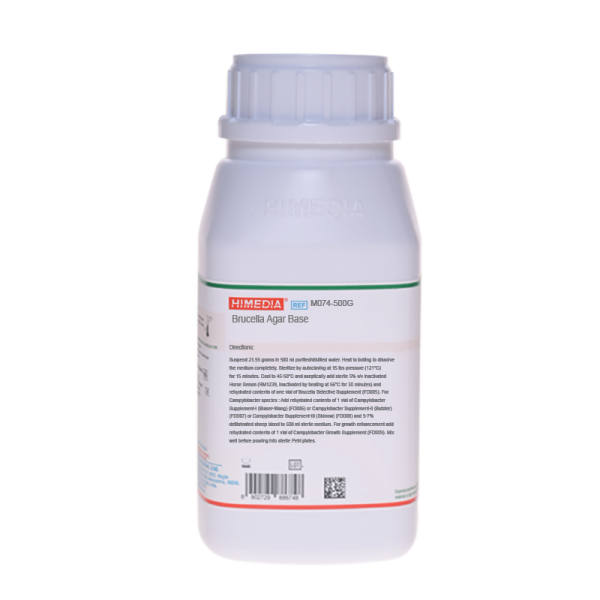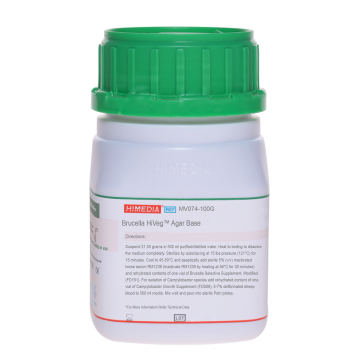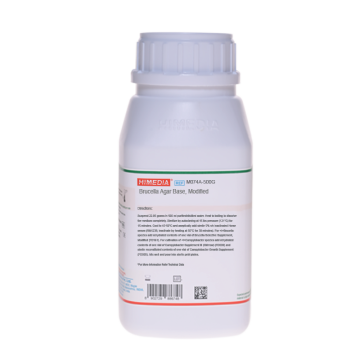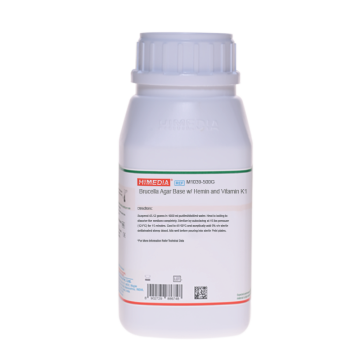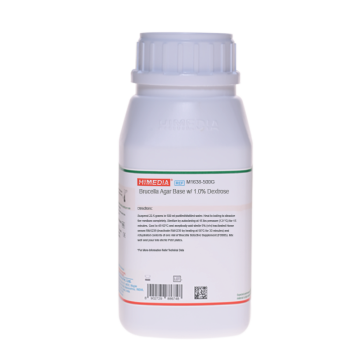 Your enquiry has been submitted
Your enquiry has been submitted
Brucella Agar Base
Non Selective Media#CC293D
Intended Use:
Recommended for enrichment, isolation and cultivation of Brucella or Campylobacter species from clinical and non-clinical specimens.
Composition**
| Ingredients | g/L |
|---|---|
| Tryptone | 10.000 |
| Peptone | 10.000 |
| Yeast extract | 2.000 |
| Dextrose (Glucose) | 1.000 |
| Sodium chloride | 5.000 |
| Sodium bisulphite | 0.100 |
| Agar | 15.000 |
| Final pH (at 25°C) | 7.0±0.2 |
**Formula adjusted, standardized to suit performance parameters
Directions
Suspend 21.55 grams in 500 ml purified / distilled water. Heat to boiling to dissolve the medium completely. Sterilize by autoclaving at 15lbs pressure (121°C) for 15 minutes. Cool to 45-50°C. Mix well and pour into sterile Petri plates.
If required, for additional selectivity of Brucella species: Aseptically add sterile 5% v/v inactivated Horse Serum (RM1239, inactivated by heating at 56°C for 30 minutes) and rehydrated contents of one vial of NPBCVN Selective Supplement (FD005).
For Campylobacter: Add rehydrated contents of 1 vial of Blaser-Wang Selective Supplement (FD006) or Butzler Selective Supplement (FD007) or Skirrow Selective Supplement (FD008) and 5-7% defibrinated sheep blood to 500 ml sterile medium. For growth enhancement add rehydrated contents of 1 vial of Minerals Growth Supplement (FD009). Mix well before pouring into sterile Petri plates.
Principle And Interpretation
Brucella are intracellular parasites that cause epizootic abortions in animals and septicemic febrile illness or localized infections of bone, tissue or organ systems in humans (1,2). Brucella species are highly fastidious and therefore require a nutrient rich medium to be able to grow. Also, Brucella species are highly infective and so extreme care should be taken while handling. Brucella Agar Base is used for the isolation and cultivation of Brucella species. The basal medium (with addition of Campylobacter Supplements) can be also used for the isolation of Campylobacter (3). Brucella Medium is a modified medium formulated to support luxuriant growth of fastidious bacteria like Brucella, streptococci, pneumococci, Listeria, Neisseria meningitides and Haemophilus influenzae (4). Brucella Agar is also recommended by APHA for isolation of Brucella species from foods (5).
Tryptone and peptone provide nitrogen and carbon source, long chain amino acids, vitamins and other essential nutrients. Yeast extract serves as a source of vitamin B complex, and additionally it also supplies some nitrogenous nutrients. Sodium bisulphite is a reducing agent and sodium chloride helps to maintain the osmotic equilibrium of the medium. Dextrose serves as an energy source. The medium can also be enriched with 5% v/v sterile defibrinated horse blood. For selective isolation of Brucella species antibiotic mixtures in the form of freeze dried supplements (FD) are incorporated into the base (6,7,8).
Type of specimen
Clinical : stool samples, rectal swabs, etc., Food samples
Specimen Collection and Handling
For clinical samples follow appropriate techniques for handling specimens as per established guidelines (4,9).
Swab specimens can be directly streaked on the plate. Liquid specimens can be inoculated by means of an inoculation loop. When non-selective medium is required, Brucella Broth Base may be employed with the addition of serum only (i.e. without antibiotics).
Warning and Precautions
In Vitro diagnostic use. For professional use only. Read the label before opening the container. Wear protective gloves/protective clothing/eye protection/face protection. Follow good microbiological lab practices while handling specimens and culture. Standard precautions as per established guidelines should be followed while handling clinical specimens. Safety guidelines may be referred in individual safety data sheets.
Limitations
- Individual organisms differ in their growth requirement and may show variable growth patterns on the medium.
- All presumptive anaerobic organisms must be identified by confirmatory test.
Performance and Evaluation
Performance of the medium is expected when used as per the direction on the label within the expiry period when stored at recommended temperature.
Quality Control
Appearance Cream to yellow homogeneous free flowing powder
Gelling Firm, comparable with 1.5% Agar gel
Colour and Clarity of prepared medium Yellow coloured, clear to slightly opalescent gel forms in Petri plates
Reaction Reaction of 4.31% w/v aqueous solution at 25°C. pH: 7.0±0.2
pH 6.80-7.20
Cultural Response
Cultural characteristics observed after an incubation at 35-37°C for 24-72 hours in presence of 10% CO2 with added sterile 5% v/v inactivated horse serum (RM1239) and NPBCVN Selective Supplement (FD005).
| Organism | Inoculum (CFU) | Growth |
|---|---|---|
| Brucella melitensis ATCC 4309 | 50-100 | luxuriant |
| Brucella suis ATCC 4314 | 50-100 | luxuriant |
| Staphylococcus aureus subsp. aureus ATCC 25923 (00034*) | >=104 | inhibited |
| Escherichia coli ATCC 25922 (00013*) | >=104 | inhibited |
Key: (*) Corresponding WDCM numbers.
Storage and Shelf Life
Store below 10-30°C in a tightly closed container and the prepared medium at 2-8°C. Use before expiry date on the label. On opening, product should be properly stored dry, after tightly capping the bottle in order to prevent lump formation due to the hygroscopic nature of the product. Improper storage of the product may lead to lump formation. Store in dry ventilated area protected from extremes of temperature and sources of ignition Seal the container tightly after use. Product performance is best if used within stated expiry period.
Disposal
User must ensure safe disposal by autoclaving and/or incineration of used or unusable preparations of this product. Follow established laboratory procedures in disposing of infectious materials and material that comes into contact with clinical sample must be decontaminated and disposed of in accordance with current laboratory techniques (4,9).
Reference
- Moyer N. P., and Holcomb L. A., Laboratory Diagnosis and Infectious Diseases: Principles and Practice, Vol. I, Springer-Verlag, New York.
- Smith L. D., and Fient T. A., 1990, Crit. Rev. Microbiol., 17: 209-230.
- Murray P. R., Baron E. J., Jorgensen J. H., Pfaller M. A., Yolken R. H., (Eds.), 8th Ed., 2003, Manual of Clinical Microbiology, ASM, Washington, D.C.
- Jorgensen, J.H., Pfaller, M.A., Carroll, K.C., Funke, G., Landry, M.L., Richter, S.S and Warnock., D.W. (2015) Manual of Clinical Microbiology, 11th Edition. Vol. 1.
- Salfinger Y., and Tortorello M.L. 2015, Compendium of Methods for the Microbiological Examination of Foods, 5th Ed., American Public Health Association, Washington, D.C.
- Jones L. M. and Brinley M. W. J., 1958, Bull. Wld. Hlth. Org., 19:200.
- Kuzdas C. D., and Morse E. V., 1953, J. Bacteriol., 66 (4):502
- Renoux G., 1954, Ann. Inst. Pasteur, 87 (3):325.
- Isenberg, H.D. Clinical Microbiology Procedures Handbook 2nd Edition.
| Product Name | Brucella Agar Base |
|---|---|
| SKU | M074 |
| Product Type | Regular |
| Physical Form | Powder |
| Origin | Animal |
| Packaging type | HDPE |
| References | 1.Moyer N. P., and Holcomb L. A., Laboratory Diagnosis and Infectious Diseases: Principles and Practice, Vol. I, Springer-Verlag, New York2.Smith L. D., and Fient T. A., 1990, Crit. Rev.Microbiol., 17 : 209-2303.Murray P. R., Baron E. J., Jorgensen J. H., Pfaller M. A., Yolken R. H., (Eds.), 8th Ed., 2003, Manual of Clinical Microbiology,ASM, Washington, D.C. 4.Finegold et al, (Ed.), 1990, Bailey and Scotts Diagnostic Microbiology, 8th Ed., The C.V. Mosby Co., St. Louis5.Vanderzant C. and Splittstoesser D. F., (Eds.), 1992, Compendium of Methods for the Microbiological Examination of Foods,3rd Ed., APHA, Washington, D.C. 6.Jones L. M. and Brinley M. W. J., 1958, Bull. Wld. Hlth. Org., 19:200. 7.Kuzdas C. D., and Morse E. V., 1953, J. Bacteriol., 66 (4):5028.Renoux G., 1954, Ann. Inst. Pasteur, 87 (3):325.9.Lapage S., Shelton J. and Mitchell T., 1970, Methods in Microbiology, Norris J. and Ribbons D., (Eds.), Vol. 3A, AcademicPress, London.10.MacFaddin J. F., 2000, Biochemical Tests for Identification of Medical Bacteria, 3rd Ed., Lippincott, Williams andWilkins, Baltimore. |
| Customized Product Available | No |



